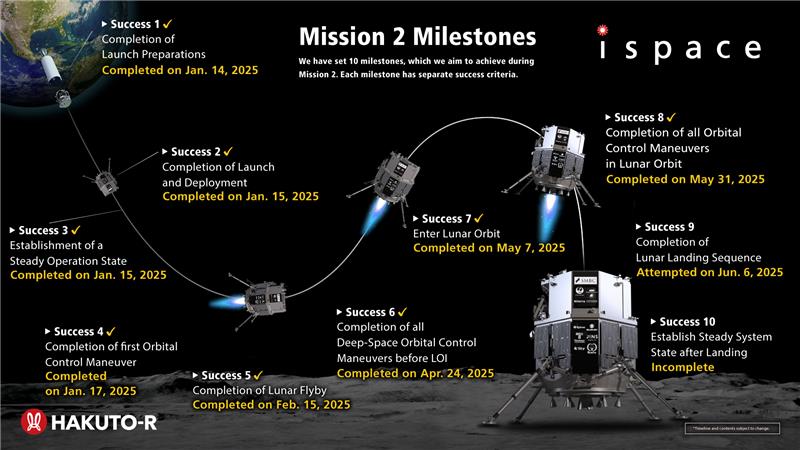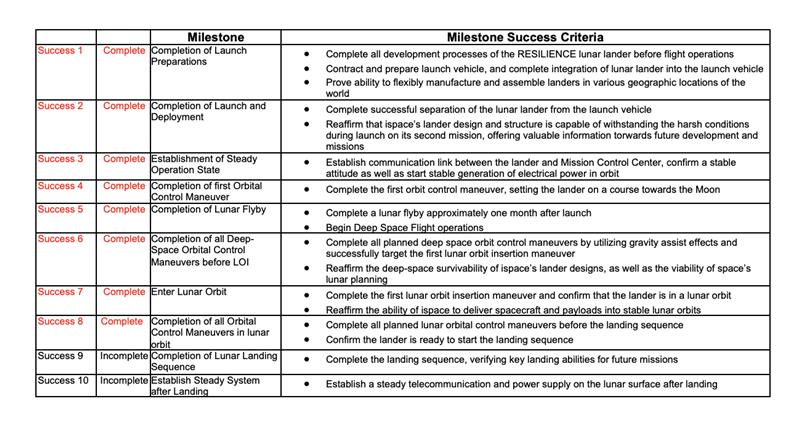24 Jun, 2025
TOKYO–June 24, 2025–ispace, inc. (ispace) (TOKYO: 9348), a global lunar exploration company, announced today that it has completed the analysis of flight data of Mission 2 “SMBC x HAKUTO-R VENTURE MOON”, obtained by the HAKUTO-R Mission Control Center, regarding the landing sequence of the RESILIENCE lander on June 6, 2025.
The analysis identifies an anomaly in the Laser Range Finder (LRF) that resulted in the hard landing, narrowed down the most likely causes of the anomaly, and completed the consideration of countermeasures and analysis of the impact on subsequent missions.
Mission 2: Analysis of factors contributing to the hard landing
- At a June 6, 2025, press conference, ispace announced: 1. during the final phase of the landing, the lander’s attitude was nearly vertical, 2. the acquisition of valid measurements from the LRF was delayed, 3. the lander was unable to decelerate to the necessary speed for a lunar landing, and 4. there was a high likelihood that a hard landing on the lunar surface had occurred.
- Analysis of results as of June 24, 2025: Through subsequent and further analysis of telemetry data acquired from the lander confirmed that the technical cause of the hard landing was an anomaly in the LRF hardware. The review also confirmed the issue was not related to the landing guidance control software, nor was it caused by anomalies in the propulsion system or other systems such as power supply.
- Based on this conclusion, verification of the LRF anomaly was conducted, focusing on two possibilities:
- Potential error in the installation direction during assembly, manufacturing and/or testing, or abnormal attitude of the lander during descent
- Deterioration of LRF performance during flight or performance that was lower than expected
- The review detected no errors in the installation direction during AIT or attitude abnormalities during descent. The review therefore concluded that the possibility of “deterioration in the performance of the LRF during flight or the performance itself was lower than expected” is high.
This information, including implementing countermeasures and improvements, will be incorporated into planning future missions.
- As a result of the review ispace has also determined that it will undertake the following initiatives:
- Launch an external review task force including third-party experts
- Implement further improvement of technical capabilities through expanded collaboration with the Japan Aerospace Exploration Agency (JAXA)
Impact on Future Missions
Based on the technical analysis and improvement plan, the re-selection of landing sensors such as LRFs and the review and expansion of testing are estimated to increase combined development costs by a maximum of approximately 1.5 billion yen for Mission 3 (official name: Team Draper Commercial Mission 1) and Mission 4. These costs are expected to be recognized on a phased basis during the period leading up to the planned launches in 2027, so there is no expected impact on the consolidated performance forecast for the fiscal year ending March 2026 and no revisions are needed. There is no expected impact on the current launch schedule for Missions 3 and 4.
Statement of Takeshi Hakamada, Founder & CEO of ispace
“On June 6, despite the united efforts and dedication of the ispace team, our second attempt at a lunar landing was unsuccessful, resulting in deep disappointment. We deeply regret that we were unable to meet the expectations of our shareholders, payload customers, HAKUTO-R partners, government officials, and all others who supported us.
“Since the moment of landing, we have remained committed to moving forward and identifying the root causes. For the past 18 days, every employee has worked tirelessly to be able to transparently share the results of the technical cause analysis.
“ispace will not let this be a setback. We will not stop here, but as determined pioneers of the cislunar economy, we will strive to regain the trust of all stakeholders and embark on the next mission. “Never Quit the Lunar Quest.”
Mission 2 Milestones


ispace is leveraging its global presence through its three business units in Japan, the U.S., and Luxembourg, for the simultaneous development of upcoming missions. Team Draper Commercial Mission 1 is also known as ispace’s Mission 3. Mission 3, debuting the APEX 1.0 lunar lander, is expected to launch in 2027. The company’s fourth mission, which will utilize the Series 3 lander, currently being designed in Japan, is scheduled to be launched by 2027.
About ispace, inc. (https://ispace-inc.com)
ispace, a global lunar resource development company with the vision, “Expand our planet. Expand our future.”, specializes in designing and building lunar landers and rovers. ispace aims to extend the sphere of human life into space and create a sustainable world by providing high-frequency, low-cost transportation services to the Moon. The company has business entities in Japan, Luxembourg, and the United States with more than 300 employees worldwide. For more information, visit: www.ispace-inc.com and follow us on X: @ispace_inc.